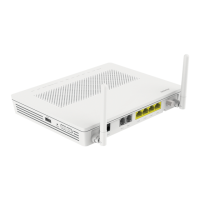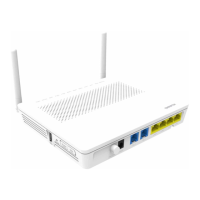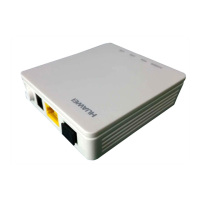– If Control flag is deactive, run the ont activate command in the GPON port mode
to activate the ONT.
– If the ONT fails to be in the up state, that is, Run state is offline, the physical line
may be broken or the optical transceiver may be damaged. You need to check both
the material and the line.
– If the ONT state fails, that is, Config state is failed, the ONT capability set
outmatches the actual ONT capabilities (For details about the ONT actual
capabilities, see Reference of GPON ONT Capability Sets. In this case, run the
display ont failed-configuration command in the diagnosis mode to check the
failed configuration item and the failure cause. Then, rectify the fault according to
actual conditions.
NOTE
If an ONT supports only four queues, the values of 4–7 of the priority-queue parameter in the
gem add command are invalid. After configuration recovers, Config state will be failed.
– If the ONT does not match, that is, Match state is mismatch, the port types and
number of ports undermatch the actual port types and number of ports supported
by the ONT. In this case, run the display ont capability command to query the
actual capability of the ONT, and then select one of the following modes to modify
the ONT configuration:
– Create a proper ONT profile according to the actual capability of the ONT, and
then run the ont modify command to modify the configuration data of the ONT.
– Modify the ONT profile according to the actual capability of the ONT and save
the modification. Then, the ONT automatically recovers the configuration
successfully.
7. Configure a traffic profile.
Run the display traffic table ip command to query the existing traffic profiles in the
system. If the existing traffic profiles in the system do not meet the requirements, run
the traffic table ip command to create a traffic profile.
The profile ID is 9, no rate limitation in the upstream and downstream directions, the
priority is 6, and packets are scheduled according to the priority carried.
huawei(config-if-gpon-0/1)#quit
huawei(config)#traffic table ip index 9 cir off priority 6 priority-policy
tag-In-Package
8. Create service ports.
Set the service port indexes to 3 and 4, SVLAN ID to 200, GEM port ID to 2, and
CVLAN ID to 20. Use traffic profile 9.
huawei(config-if-gpon-0/1)#quit
huawei(config)#service-port 3 vlan 200 gpon 0/1/1 ont 1 gemport 2 multi-
service user-vlan 20 rx-cttr 9 tx-cttr 9
huawei(config)#service-port 4 vlan 200 gpon 0/1/1 ont 2 gemport 2 multi-
service user-vlan 20 rx-cttr 9 tx-cttr 9
9. Configure the queue scheduling mode.
Use the 3PQ+5WRR queue scheduling. Queues 0-4 adopt the WRR mode, with the
weights of 10, 10, 20, 20, and 40 respectively; queues 5-7 adopt the PQ mode.
NOTE
Queue scheduling is a global configuration. You need to configure queue scheduling only once on
the OLT, and then the configuration takes effect globally. In the subsequent phases, you do not need
to configure queue scheduling repeatedly when configuring other services.
huawei(config)#queue-scheduler wrr 10 10 20 20 40 0 0 0
EchoLife HG8240/HG8245/HG8247 GPON Terminal
Service Manual 3 Configuration
Issue 04 (2011-01-12) Huawei Proprietary and Confidential
Copyright © Huawei Technologies Co., Ltd.
3-141

